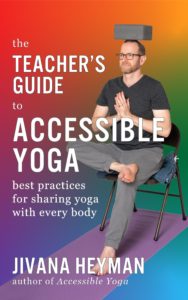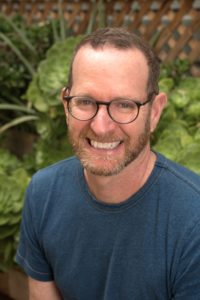
by Jivana Heyman
Today I’m excited to share with you an short excerpt from my latest book, The Teacher’s Guide to Accessible Yoga. My hope is that this book will be a companion along the path for new and experienced yoga teachers and yoga therapists. I offer tips and skills for teaching in a way that welcomes all students into your classes. I also reflect on the student/teacher relationship, and the internal process that we go through to take the seat of teacher. For further information, see The Teacher’s Guide to Accessible Yoga.
I’m also giving away a copy of the book! To be entered to win, please fill out this giveway contest form. We’ll randomly pick a winner on March 20, 2024.
Excerpt from The Teacher’s Guide to Accessible Yoga: Impostor Syndrome
In order to teach what you love, you need to overcome some of the challenges of becoming a teacher. Personally I found that the biggest hurdle was overcoming my insecurities. I’ve struggled with shyness my whole life. I would never speak in school, and I dreaded having the teacher call on me. I think I was so concerned about what others thought about me that I was frozen with fear. The first few years that I was teaching yoga, I would panic before each class and arrive sweaty, blushing, voice quaking.
In the very first class I ever taught, I had a student who was crying in the front of the class the entire time, and I didn’t know what to do. She came in, laid down on her mat, and began crying as soon as class started. I was so overwhelmed with remembering what to say that I just had to ignore her. She came up to me after class and thanked me for letting her have the space to cry. She said she just felt like she needed to be in a safe place with other people.
I’m so glad that worked out because I didn’t know what else to do. I was overcome with what I would call imposter syndrome. I didn’t feel like I was capable of or fit for the job of yoga teacher, and in many ways I wasn’t. That’s the thing about imposter syndrome, there is usually a kernel of truth to it. But the question that we’re faced with is: How am I going to respond to that truth?
We can turn toward it, and recognize our limitations, or we can ignore those feelings, and allow the imposter syndrome to grow into a paralyzing monster within us. The choice is ours. Luckily, with an effective practice, we have the opportunity for honest reflection, svadhyaya.
The truth is, I was a brand new teacher, and in many ways I was an imposter because I didn’t really know what I was doing. At the same time, I was being honest with my students and myself that I was new. Taking the seat of a teacher is a high calling. It means that I practice yoga’s ethical values to the best of my ability. It doesn’t mean that I have to be a perfect being, but it does mean that when I mess up, I’m honest about it.
The problem with imposter syndrome is that if it goes too far it can paralyze you. How do you ever become an experienced teacher if you don’t allow yourself to be a new teacher? The way to become masterful at something is by learning from your mistakes, and being honest with yourself. If I’m teaching a class and I’m 100 percent satisfied with myself as a teacher how can I improve? If I can see where I might have made an error, or how I could have done better, that inspires me to grow and learn so I can become a better teacher.
For me, the other kernel of truth in imposter syndrome is that yoga is a massive subject. Yoga has grown and evolved over thousands of years in endless threads and traditions. It’s impossible to be an expert on all of yoga. Rather, you can focus on one part that is meaningful to you and useful for your students. You can also be honest about the things you don’t know.
You also have to be aware of your positionality. If you’re not of South Asian descent, then you need to consider your relationship to the teachings. If you’re only using the teachings for profit and approaching yoga teaching just as a job, then you may be appropriating an ancient indigenous practice that has already been, and is still very much being, colonized and abused by Westerners.
It’s also important to acknowledge that the history and traditions of yoga are not without problems themselves. Not only has there been tremendous abuse in yoga, but the way that caste is embedded in the yoga teachings is very problematic. The caste system made the teachings of yoga inaccessible to many, and our teaching today needs to be part of the effort to debrahmanize yoga, which is to remove caste from the way we teach and practice.
So it’s not surprising that we often feel like imposters when identifying ourselves as yoga teachers, regardless of our background or knowledge. I recently interviewed Indu Arora, who is one of the most knowledgeable yoga teachers I know, and she shared that she still sees herself as primarily a student even though she has been teaching for decades.
Like I said, there’s a kernel of truth to imposter syndrome, and we can use this truth to learn and grow. In fact, it reminds me of the yoga teachings about ego. Patanjali describes ego as a case of mistaken identity. The body and mind have lay claim to the power of the spirit. He explains, “Egoism, asmita, is the identification, as it were, of the power of the Seer (Purusha) with that of the instrument of seeing [body‑mind].”
 Jivana Heyman, C-IAYT, E-RYT500, is the founder and director of Accessible Yoga, an organization dedicated to increasing access to the yoga teachings and supporting yoga teachers. He’s the author of the books: Accessible Yoga: Poses and Practices for Every Body; Yoga Revolution: Building a Practice of Courage & Compassion; and a new book, The Teacher’s Guide to Accessible Yoga: Best Practices for Sharing Yoga with Every Body. Over the past thirty years of teaching yoga, Jivana has focused on welcoming all people to yoga and celebrating our individuality and our differences. His work has focused on dismantling ableism in the yoga world, as well as looking at the intersection of yoga and social justice. His books, classes, and trainings offer support to yoga teachers and yoga therapists in finding ways to bring creativity and collaboration into their teaching while still respecting the ancient yoga tradition.
Jivana Heyman, C-IAYT, E-RYT500, is the founder and director of Accessible Yoga, an organization dedicated to increasing access to the yoga teachings and supporting yoga teachers. He’s the author of the books: Accessible Yoga: Poses and Practices for Every Body; Yoga Revolution: Building a Practice of Courage & Compassion; and a new book, The Teacher’s Guide to Accessible Yoga: Best Practices for Sharing Yoga with Every Body. Over the past thirty years of teaching yoga, Jivana has focused on welcoming all people to yoga and celebrating our individuality and our differences. His work has focused on dismantling ableism in the yoga world, as well as looking at the intersection of yoga and social justice. His books, classes, and trainings offer support to yoga teachers and yoga therapists in finding ways to bring creativity and collaboration into their teaching while still respecting the ancient yoga tradition.
The Teacher’s Guide to Accessible Yoga is available in paperback, ebook, and audiobook, wherever books are sold. More information at jivanaheyman.com.
Are you wondering what Nina Zolotow is up to these days? Check out her Delusiastic! blog for tiny stories and creative non-fiction or sign up for her emails here


Can’t wait to read it!
Insightful article. It’s so important to remain humble as a teacher. We are all students.